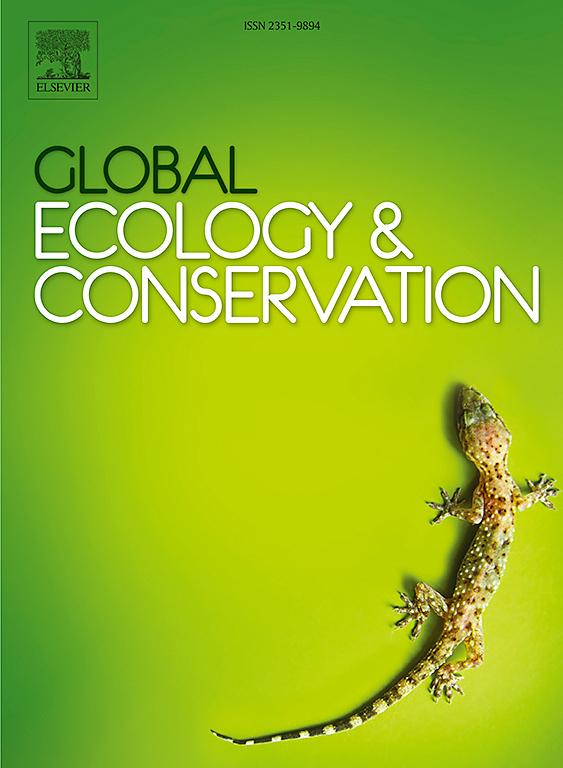Effectiveness of the protected area for the plant species diversity conservation under the changing climate
IF 3.5
2区 环境科学与生态学
Q1 BIODIVERSITY CONSERVATION
引用次数: 0
Abstract
Protected areas (PAs) play a crucial role in safeguarding biodiversity, but their effectiveness under climate change remains uncertain. Studies suggest that PAs are often biasedly distributed, potentially limiting their ability to protect important wildlife. This study assesses whether Japan’s PAs can serve as refugia for native temperate plant species under future climate scenarios. Approximately 20.5 % of Japan’s total land area is designated as PAs, categorized into three ranks based on the strictness of legal protection. The study considered 2260 native temperate plant species and used climate data from the WorldClim database, incorporating 12 general circulation models (GCMs) and four shared socioeconomic pathways (SSPs). Species distribution models were developed using MaxEnt to predict changes in species richness, habitat availability and extinction likelihood for native temperate plants under two migration scenarios: full migration, where species can freely shift ranges, and no migration, where species remain within current habitats. The results showed significant variability in species richness across GCMs within the same SSP scenario. As global CO2 concentrations increase, species richness is projected to decline, with greater losses in the no migration scenario compared to full migration. Despite these losses, even under the extreme SSP585 scenario and no migration, most native temperate plant species are expected to retain over 50 % of their potential habitats within PAs, resulting in a low risk of species extinction from all PAs. These findings suggest that Japan’s native temperate plant species may retain their potential habitats within PAs even under the most extreme climate scenarios.
气候变化下保护区对植物物种多样性保护的有效性
保护区在保护生物多样性方面发挥着至关重要的作用,但其在气候变化背景下的有效性仍不确定。研究表明,保护区往往分布不均,这可能会限制它们保护重要野生动物的能力。本研究评估了在未来气候情景下,日本保护区是否可以作为本土温带植物物种的避难所。日本国土面积的20.5% 被指定为保护区,根据法律保护的严格程度分为三个等级。该研究考虑了2260种温带原生植物,并利用WorldClim数据库的气候数据,结合了12种大气环流模型(GCMs)和4种共享社会经济路径(ssp)。利用MaxEnt建立了物种分布模型,预测了两种迁移情景下温带原生植物物种丰富度、栖息地可用性和灭绝可能性的变化:完全迁移(物种可以自由迁移)和不迁移(物种保持在现有栖息地)。结果表明,在相同的SSP情景下,不同gcm的物种丰富度存在显著差异。随着全球二氧化碳浓度的增加,物种丰富度预计将下降,与完全迁移情景相比,无迁移情景的物种丰富度损失更大。尽管存在这些损失,但即使在极端的SSP585情景和没有迁移的情况下,大多数温带原生植物物种预计将在保护区保留超过50% %的潜在栖息地,从而导致所有保护区的物种灭绝风险较低。这些发现表明,即使在最极端的气候情景下,日本本土温带植物物种也可能在保护区内保留其潜在栖息地。
本文章由计算机程序翻译,如有差异,请以英文原文为准。
求助全文
约1分钟内获得全文
求助全文
来源期刊

Global Ecology and Conservation
Agricultural and Biological Sciences-Ecology, Evolution, Behavior and Systematics
CiteScore
8.10
自引率
5.00%
发文量
346
审稿时长
83 days
期刊介绍:
Global Ecology and Conservation is a peer-reviewed, open-access journal covering all sub-disciplines of ecological and conservation science: from theory to practice, from molecules to ecosystems, from regional to global. The fields covered include: organismal, population, community, and ecosystem ecology; physiological, evolutionary, and behavioral ecology; and conservation science.
 求助内容:
求助内容: 应助结果提醒方式:
应助结果提醒方式:


